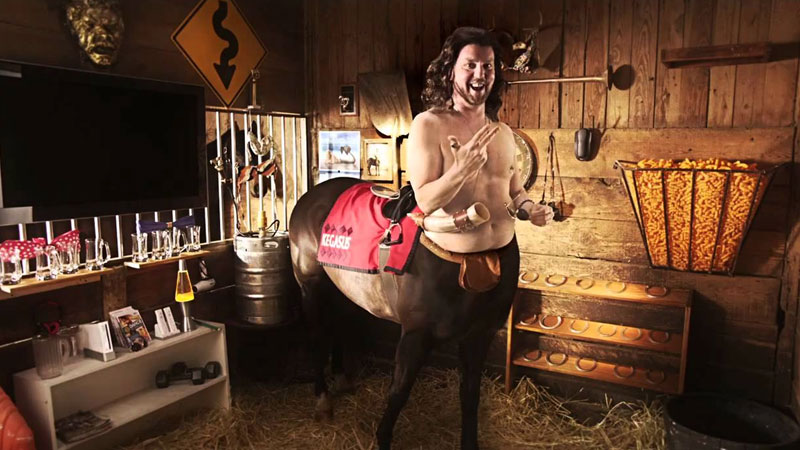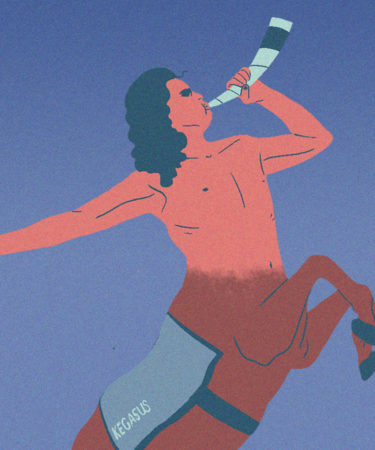Baltimore’s Pimlico stadium has seen its share of equine greats: Seabiscuit; War Admiral; Secretariat. In 2011 and 2012, another type of four-legged celebrity graced the site of the annual Preakness Stakes race. The barrel-chested, shirtless centaur, with flowing shoulder-length hair and aviator sunglasses, exhorted racing fans in an indeterminate accent to “be legendary.” This was Kegasus, Lord of the InfieldFest.
In 2009, after years of alcohol-fueled, out-of-control parties at the Pimlico infield threatened to sully the reputation of the Preakness, the Maryland Jockey Club decided to ban outside beverages from the event. While the decision may have been good for the health and safety of Preakness attendees, it was bad for business — attendance at that year’s race dropped by nearly 25 percent.
In need of a way to reinject some youthful appeal to an event held since 1873, the Jockey Club partnered with Washington, D.C.-based marketing agency Elevation Ltd. to correct the course. In 2011, the club debuted Kegasus, a “half-man, half-thoroughbred, party manimal” who starred in a series of advertisements that drew attention to both the upcoming InfieldFest’s all-you-can-drink “Mug Club,” and musical guests Bruno Mars and Train.

Baltimore officials didn’t buy it. Maryland State Delegate Pat McDonough was “disgusted” with the campaign, saying, “Kegasus is infantile and creates a negative image.” University of Maryland media professor Jason Loviglio suggested that the mascot would encourage binge drinking. Baltimore Health Commissioner Dr. Oxiris Barbot decried Kegasus a symbol of “alcohol overindulgence that appeals to largely adolescent boys.” And in a press release headlined “Preakness mascot’s gut and nipple ring raise ire,” the Associated Press reported that the character’s catchphrase, “be legendary,” was a plain reference “to the infield’s reputation for hard partying.”
Nevertheless, Kegasus persisted. John C. Bailey, the actor who portrayed Kegasus, honed the character in a series of promotional bar crawls that entailed dragging the 50-pound, wheeled horse-like costume around Baltimore for hours on end. It didn’t matter if the events occasionally got rowdy, he says, because “everyone in Baltimore” embraced Kegasus: “He was half-god, half-Baltimorean,” Bailey tells VinePair. “He was a local.”
Bailey tells VinePair, “I was very protective of the character,” adding that any criticism that Kegasus was somehow cheapening the Preakness was misplaced. “He wasn’t there to represent the Preakness. He was there to represent the InfieldFest,” which Bailey considered a much more populist event than the dressed-up viewing parties in the grandstand. In the press leading up to the event, he offered such generous perspectives as: “[P]art of being legendary is being responsible,” he told The Paulick Report in 2017. “It is far from legendary to find oneself passed out in the middle of the track so that no one can see who wins the Preakness.”
Despite — or perhaps because of — the negative attention, attendance at the Preakness rebounded. In character as Kegasus, Bailey says he was often credited by revelers as their deciding factor to attend. “A lot of people — and not just millennials, but older people, baby boomers, would tell me, ‘I would never have come to InfieldFest before,’ given its hard-partying reputation, ‘but [Kegasus] made it cool.’ ”
Kegasus returned for the 2012 race, this time accompanied by a “half-unicorn” sidekick/assistant, Unicarl. The following year, the Maryland Jockey Club decided to put Kegasus out to pasture. (Maryland Jockey Club President Tom Chuckas told Business Journal that the InfieldFest’s extremely 2013 musical guests — Pitbull and Macklemore — would be enough to draw a crowd.)
“At the time, I understood that they accomplished what they needed to accomplish,” Bailey says, noting that Kegasus helped “[shift] the demographic [of InfieldFest] from people who brought in trash cans full of beer,” to people who were just looking for some “goofy fun.”
Meanwhile, Chuckas said simply that his organization had “never hidden the fact that they want young people to come to the infield and party. ” He later told the Washington Post, “Kegasus brought the spirit of fun and energy tailored towards a younger demographic,” making the 2011 event “one of the most successful InfieldFests in history.”
Following his retirement, post-Kegasus Preakness attendance remained in the six-digits. With this year’s race rescheduled to October and attendance remaining in question, one can’t help but wonder whether the time will come for Kegasus to return from Mount Olympus.
Summing up the “half-god, half-Baltimorean” centaur’s brief but memorable reign, Bailey was succinct: “If nothing else, he was entertaining.”
